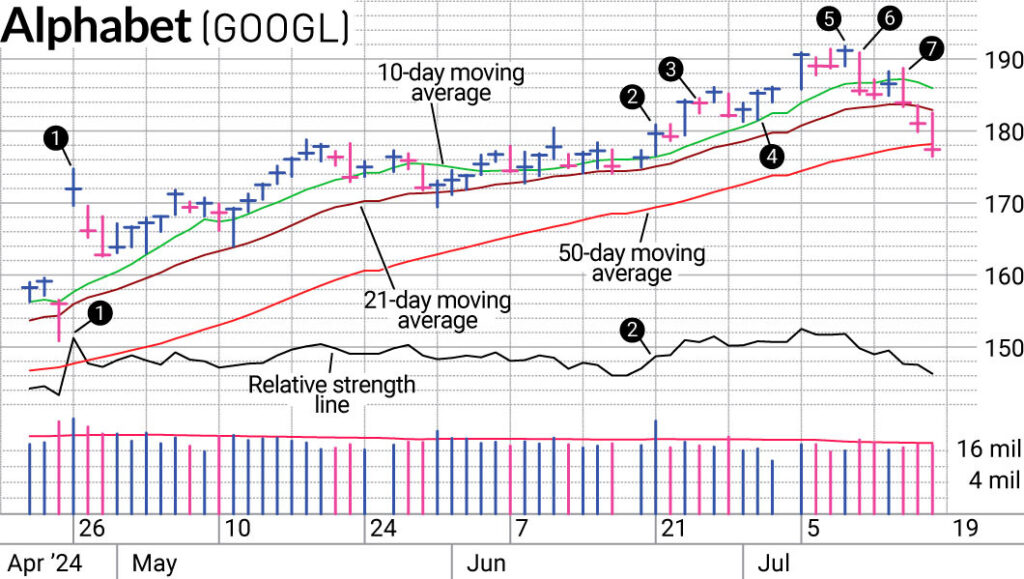After numerous false starts for a potential rotation, is this one for real? After a heavy leaning toward the “Magnificent Seven” type stocks, we made an about face from megacaps to small caps. Big Tech to non-tech. Here’s how it unfolded with Google stock and why we made the shift.
↑
X
Ro-fake-tion No More! How Thursday Was A Turning Point
A Setup In Google Stock
Last week’s column mentioned the “canary in the coal mine” as software, specifically ServiceNow (NOW), started looking sick. That sickness spread. But prior to that, Google parent company Alphabet (GOOGL) had a number of positive elements to its trade.
Its last earnings report vaulted Google stock up over 10% with a strong close (1). Notably the relative strength line popped to highs as well.
But it was a while before Google stock piqued our interest. While it made progress in price, its relative strength line lagged during much of the rally that started in May. It was on June 21 when the price broke above resistance around 180, and the relative strength line simultaneously broke a downtrend (2). That was enough to earn Google a spot on SwingTrader.
Adding To What’s Working
For Google stock, we started the position at a half and increased it an extra quarter the same day. A couple days later, we made it a full position (3) as it put the resistance around 180 further below.
David Ryan shares how to recognize when a stock needs to cool off
As stocks tend to do, Google did have some tests but showed its resilience. A minor pullback immediately got support at its 10-day moving average line (4). It also looked like the 180 level was no longer an area of resistance but of support.
Even more importantly, the relative strength line continued to stretch into high ground. Google also had plenty of company from its megacap brethren. Apple (AAPL), Amazon (AMZN), Meta (META), Microsoft (MSFT) and Netflix (NFLX) were also members of SwingTrader at the beginning of a July. A common feature? They also had superior showings in their relative strength lines.
While we’ve been pretty spread out, as June unfolded to July, we saw more concentrated positions in just a few of the megacap stocks. The number of stocks went from 23 on our current trades list the day Google joined down to just nine the day before Google exited.
A large part of that was due to increased position sizes on the stocks that worked. Where did the money come from? The stocks that weren’t working, or at least weren’t moving as fast.
Extended Markets Deserve Caution
While gains piled on, it’s not a bad idea to know where the exits are at a party — even while the good times are rolling. On July 10, the Nasdaq composite was 9% above its 50-day line, a level of extension that doesn’t usually last very long. Since the megacaps drove the index to those heights, it was worth noting that Google and friends also looked extended from their moving averages (5).
That should be enough to get the warning bells ringing. The next day, the megacaps led the Nasdaq composite lower and we exited Google (6) and reduced our exposure to that area.
But we didn’t exit the market. In fact, by the close we were back at nearly 100% invested. But the makeup of the model portfolio was very different. Less tech and megacap, more financials and small-cap exposure. The relative strength lines told us where the favor shifted. Waiting for a bounce might have left you further in the downdraft (7).
The flexibility to recognize the extension and then move to the next area of interest: Such thinking put us in a position to make progress in July rather than giving it up. The relative strength lines were the key.
More details on past trades are accessible to subscribers and trialists to SwingTrader. Free trials are available. Follow Nielsen on X, formerly known as Twitter, at @IBD_JNielsen.
YOU MAY ALSO LIKE:
Want To Know Our Swing Trading Strategies? Watch This Weekly Update.
The Importance Of Downside Reversals
John Kosar Discusses Faster Rotations This Year And How To Handle Them
This Trader Shares How She Got Her First 10-Bagger With Nvidia Stock

